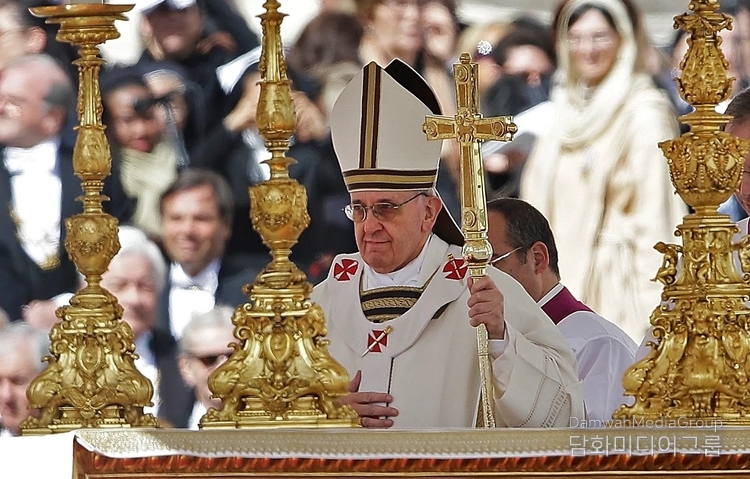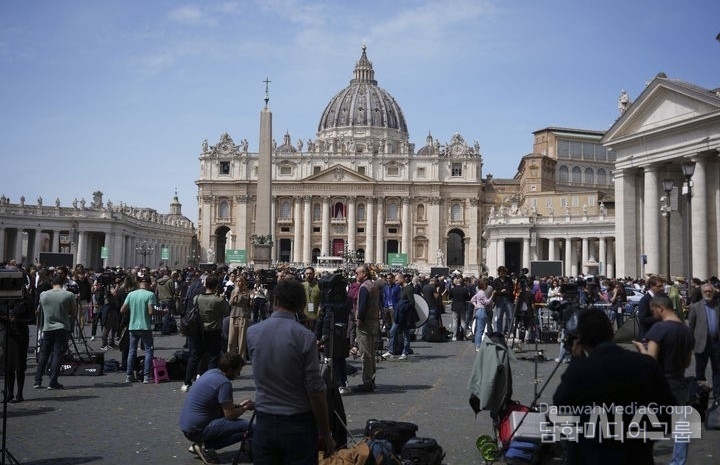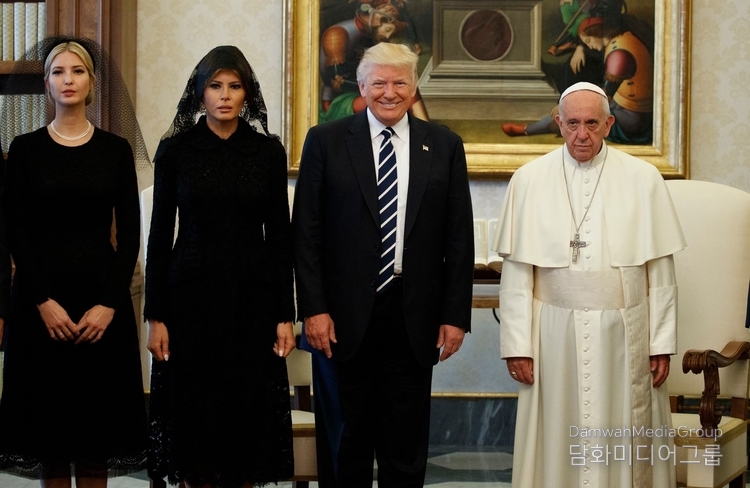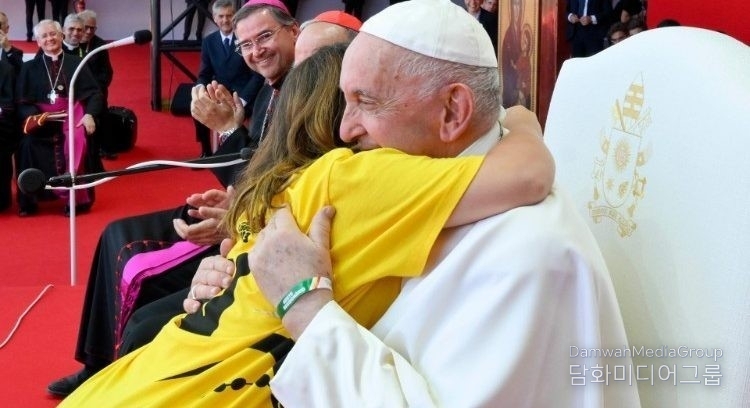By Diplomacy Journal Lee Kap-soo
From Rio to Ajaccio, circumnavigating the globe dozens of times if you consider the sheer number of kilometres travelled, Pope Francis’ 47 Apostolic Visits abroad took him and his message of closeness to every continent and almost every corner of the earth, the Vatican News reported.
Throughout the years and journeys, it became increasingly clear that he set the tone immediately when he was photographed upon his departure to Brazil in 2013, carrying his little black bag as he climbed the steps into the aircraft.

Then, during the flight, he walked up and down the aisles, personally greeting and chatting to the journalists on board, connecting with them and building down-to-earth relationships that stood the test of time.
Once landed, he refused to use an armoured vehicle, preferring to be driven in a simple car or in an open-air jeep that would enable him - again - to connect with the people, share their lives and their feelings.
It is also symbolic that Pope Francis’ first foreign trip was not a foreign visit at all, but to Lampedusa, an island in southern Italy, the port of entry to Europe for hundreds of thousands of men, women and children fleeing violence, climate change and poverty.
In choosing Lampedusa as his first visit, the Pope immediately highlighted the priority he would give to the poor and especially to migrants seeking survival, safety, a future.
From a wider perspective, it was also a symbolic embrace of the peripheries, a cornerstone of his magisterium, an unfaltering call to heed the cry of the poor, the marginalized, the weak.
Pope Francis’s travels—averaging about four journeys a year—took him to 68 different countries, each of them offering him the opportunity to call for justice, peace, inclusion and love for the entire human family.
Although his body began to let him down, obliging him to accept a wheelchair and even forcing him to cancel a visit or two, his call never weakened.
As per protocol, authorities and political leaders were always the first to receive his address at the start of an apostolic visit; according to the context and problematics of the country in question, they were never spared direct words of criticism and even condemnation as he called them to account and urged them to foster the common good.

Pope Francis’ desire to foster unity among Christian Churches
Throughout his twelve years as head of the Catholic Church, Pope Francis’ push for a greater sense of unity between all Christian Churches was evident through his words and deeds, the Vatican News reported.
Rifts between the different Christian Churches date back centuries. But rather than give in to unhealthy precedent, Pope Francis used his time in the papacy to build upon the ecumenical foundation of his predecessors to bridge the gap.
rom introducing himself as Bishop of Rome rather than Pope upon his election to becoming the first Pope to make a visit with Anglican and Reformed leaders, Pope Francis repeatedly expressed his solidarity with different Churches through his words and actions over the last twelve years.
From the moment of his election in 2013, Pope Francis’ papacy took on an ecumenical focus. During his first greeting to crowds in St. Peter’s Square, he referred to himself as the “Bishop of Rome” rather than the Pope, and this was listed as his title in the Vatican yearbook for 2013.
Historically, the title “Bishop of Rome” signified a high position among the five Patriarchates, without placing the Bishop of Rome over the Eastern Patriarchates.
Pope Francis’ use of this title was seen as respecting the papal position in relation to the leaders of other Christian Churches.
Almost a decade into his papacy, in 2022, Pope Francis reintroduced the idea of a shared date for the celebration of Easter for the Orthodox and Catholic Churches. In a meeting with Mar Awa III, Catholicos-Patriarch of the Assyrian Church of the East, the Pope said, “I want to say—indeed, to repeat—what Pope Saint Paul VI said in his day: We are ready to accept any proposal that is made together.”
During the Second Vatican Council, Pope Paul VI first proposed a set date for Easter to be held on a Sunday in April. About 50 years later, at Pope Francis’ behest, the topic once again became the center of discussion.
During the Week of Prayer for Christian Unity in 2025, the Pope reaffirmed the Catholic Church’s willingness to accept “the date that everyone wants: a date of unity.”
Seeing that the date of Easter for both the Catholic and Orthodox Churches aligned on the same day in 2025, Pope Francis called on both Churches to make a definitive effort towards unity.
His final celebration of Easter, on April 20, 2025, was remarkable for marking the rare occasion that all Christians celebrated the highest Christian feast on the same day, as the Gregorian and Julian calendars aligned.

World's Catholics mourn Pope's Easter death
From the Vatican to the Philippines, Catholics are spending their Easter Monday saying goodbye to their spiritual leader Pope Francis, the BBC reported.
His death comes at one of the most important times of the year for followers of the Roman Catholic Church, and less than 24 hours after the ailing Pope addressed worshipers in St Peter's Square on Easter Sunday.
"He [God] chose the most beautiful day for the Christian Church - he couldn't have chosen a better day," said Father Sergio Codera, a Salesian priest from Spain.
He continued: "It [Easter] is the most important occasion Christians celebrate, when we celebrate that death does not have the final word.
"And it has been this day that God has chosen for Pope Francis to meet him."
In the Vatican, there is shock from those who saw Francis perform his final public duty.
"It was very shocking - we just saw him yesterday for the Easter celebration and we received a blessing," one man in St Peter's Square told the BBC.
One woman who heard his address said: "He took his duty to the people so seriously - even when he was so unwell yesterday, he still came out, he was still part of the Easter mass, he still got to speak to us."
Church bells have been ringing out across Manila, the capital of the Philippines, where worshippers have gathered in churches to pray and reflect on the Pope's death.
Around 85% of the nation's population of 110 million are Roman Catholic, making it the church's stronghold in Asia.
Among them is Jude Aquino, an altar server who reflected on the Pope's influence on young Catholics shortly after his death was confirmed.
He told Reuters news agency: "It's a big hit against the Catholic Church because for the youth like us, he's such a big role model - a role model whom we follow since he's a vicar of Christ."

Who will be the next pope after Francis?
Speculation is already starting about most likely candidates to succeed Pope Francis as the next pontiff and pastoral leader of the world's 1.4 billion Catholics. The conclave of cardinals has the final say, the DW reported.
There's an intercontinental array of possible successors to Pope Francis, with the initial strong contenders coming from Asia, Africa, North America and Europe.
Popes are elected in a secretive and highly ritualized process called a conclave, held in Vatican City's Sistine Chapel.
Only cardinals under the age of 80 are eligible to vote, and typically about 120 of them participate. Below are some of the prospective pontiffs who will most likely be considered.
Dubbed the "Asian Francis" for his focus on social justice, Tagle is seen as the favorite in some quarters and would also be the first Asian pope — just like Francis was the first pope from the Americas. On paper, Tagle seems to have all the boxes ticked to qualify him to be a pope. However, Tagle's prospects may be dimmed due to accusations of institutional bullying in Caritas Internationalis, a global Catholic charity association, which he led for several years. The Holy See dismissed Tagle as the head of Caritas Internationalis in 2022.
A potential bridge between various Church factions, Parolin has been Francis' secretary of state since 2013 and he is among the leading contenders for the papacy. His role is the second highest in the hierarchy after pope. A career diplomat, he's been criticized by conservatives for his role in an agreement with Beijing on the appointment of bishops in communist China. His election would return the papacy to Italy after three non-Italians.
A possible first sub-Saharan African pope, Turkson blends pastoral work in Ghana with diplomatic skills and Vatican leadership experience. Francis sent Turkson as his special envoy to pursue peace in South Sudan. His strong communication skills — and the fact that he comes from one of the most dynamic regions for the Church as it struggles with secularism in Europe — should bolster his credentials.

Pontiff remembered in S. Korea for compassion, message of peace
The death of Pope Francis, who had long yearned for peace on the divided Korean Peninsula, triggered deep mourning among South Koreans on April 21, the Yonhap News reported.
The pontiff was regarded by the country's Catholics and non-believers alike as a spiritual leader who showed deep compassion and a special affection for the country.
He chose South Korea as his first destination in Asia after becoming pope in 2013 and appointed two of the four Korean cardinals to date. Under his leadership, Seoul was selected to hold the 2027 World Youth Day, making the country the second Asian country to hold the global event after the Philippines in 1995.
He also maintained close communication with South Korean presidents, consistently showing a strong interest in peace on the Korean Peninsula and inter-Korean relations.
During his five-day visit to South Korea in 2014, he met with those who were suffering or marginalized, including victims of Japan's wartime sexual slavery -- euphemistically referred to as "comfort women" -- as well as people with disabilities.
He comforted them and brought hope to Korean society, with his humble and modest demeanor, leaving a lasting impression on many.
"I wanted to meet him again and thank him in person," Kim Young-oh, the bereaved father of a Sewol ferry disaster victim, told Yonhap News Agency on Monday regarding the pontiff's death.
He met with the pope in August 2014 on the 34th day of his hunger strike to seek the truth behind the deadly sinking that left 304 people dead in April that year.
"When I thought no one would hold our hands, the pope was the person who gave us the most strength," he recalled, adding that the encounter helped trigger wider attention from media around the world.
The death brought Lee Young-su, an activist and one of the comfort women, to tears.
"He must have gone to a good place," she said. The pontiff invited seven comfort women to the front row of his Mass at Myeongdong Cathedral, the final event of his visit to South Korea.
"Meeting him brought me great peace of mind, but I am sad I couldn't meet him again after that," she said, adding: "He was someone who only did good things. I will pray for him."
Ven. Jinwoo, leader of South Korea's largest Buddhist sect, the Jogye Order, joined in mourning the death of Pope Francis, offering his "deepest condolences" to Catholics around the world.
"The pope was someone who transcends religious boundaries and shared in the suffering of humanity with humility and compassion," he said.

